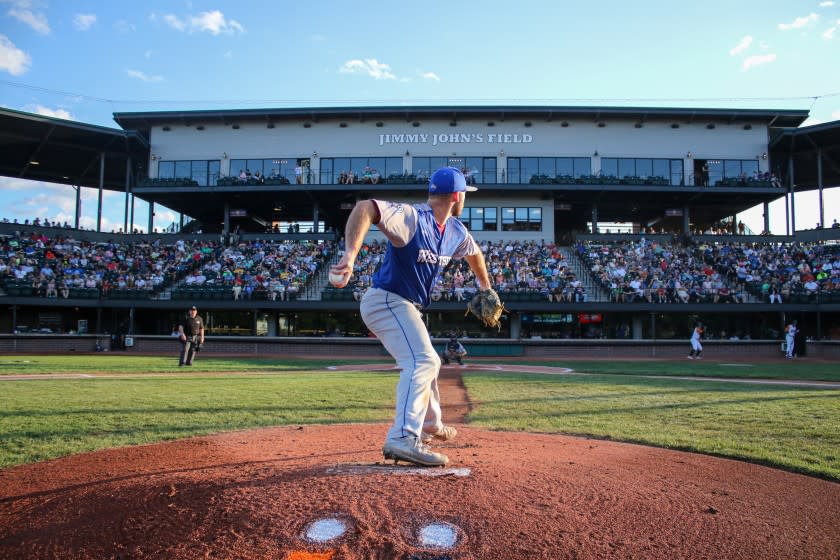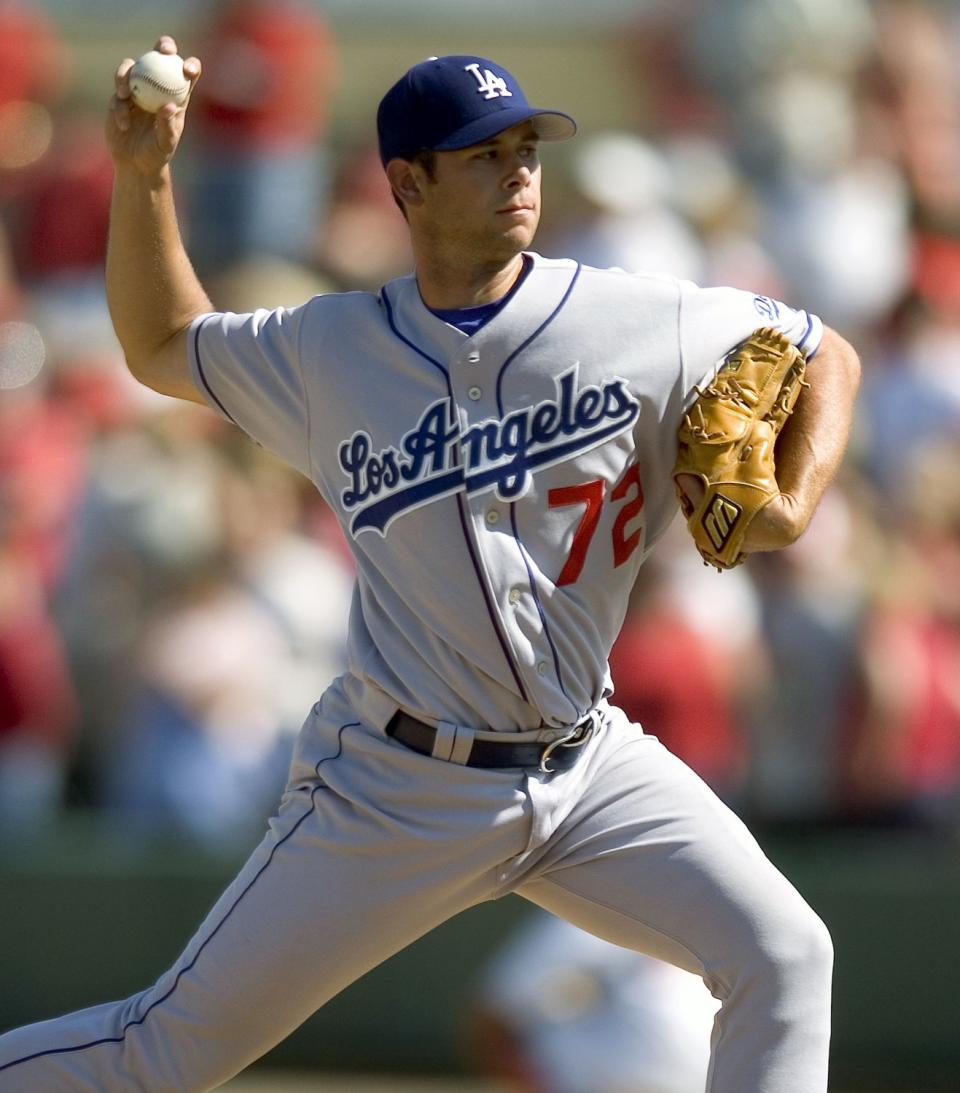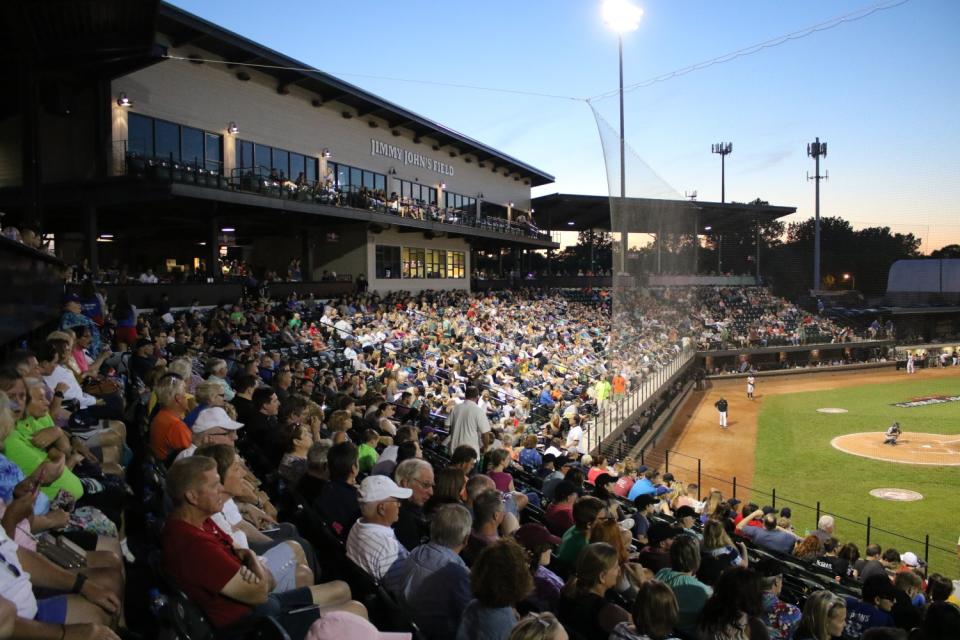Baseball on July 4? How this Dodgers alum got his league to play

For the Dodgers, training camp starts Friday, with the season three weeks away. For a prospect the Dodgers once hoped could anchor their starting rotation, the season itself starts Friday.
“Play ball!” will be heard. Professional baseball will be played.
The crowds might come later this summer. But for Justin Orenduff, the mission has not changed: Leverage technology to launch players toward the major leagues, where he long aspired to be.
In 2004, one year after Orenduff joined Justin Verlander and Jered Weaver in the Team USA rotation for the Pan Am Games, the Dodgers drafted him in the first round. In 2020, Orenduff is the director of baseball operations for the United Shore Professional Baseball League, based in Michigan.
“What we’ve set out to do, really, is to be this development league for Major League Baseball,” he said.
The USPBL offers a twist on the traditional independent circuit, the refuges for players in search of a second chance or a last chance. Players sign not with a team but with the league, which uses one ballpark, limits games almost exclusively to weekends to maximize attendance, and devotes weekdays to biomechanics, coaching and training.
The USPBL field — located in suburban Detroit, about 25 miles north of the Tigers’ Comerica Park — holds 4,500. Of the 75 dates last year, 62 were sellouts.
Although the USPBL produced a 172-page health and safety protocol in the hope of playing with about 1,000 fans, the governor’s office so far has declined to allow outdoor gatherings of more than 100. The USPBL decided to start the season anyway, with 68 players reporting last week.
Five tested positive for the novel coronavirus, Orenduff said. Those five were sent home and cannot return without proof of testing negative for the virus or testing positive for antibodies. The remaining players will be subject to protocols that include daily health checks, nightly curfews, showering at home rather than at the ballpark, a maximum of seven players in the clubhouse at one time, and bench players waiting not on the bench but “in Manager’s Suite.”
And, as part of the protocol: “In the event a manager wishes to challenge an umpire call, they will be required to maintain proper social distancing.”
The players are divided into four teams and paid $600 to $800 per month, Orenduff said.
“We see if we can develop their skills to warrant them becoming a prospect,” he said.
Orenduff was a prospect from day one, signed for a $1-million bonus, drafted ahead of future all-stars Gio Gonzalez and Huston Street at the end of the first round. He raced through rookie ball and Class A in less than a year.

In 2006, in his first full season of double-A, he beat the Montgomery Biscuits one night.
“I woke up the next day and couldn’t lift my arm up,” he said.
He had a torn labrum, had lost 80% of his bicep tendon, and the surgeon offered a sobering post-operative message: “Justin, I don’t know if you’ve got 6,000, 600 or six innings left, but I do know that the way you threw the baseball led to this.”
Orenduff had 300 innings left, many of them unsatisfactory, none of them in the majors.
“I started to go into this analysis mode,” he said, “of ‘why did I get hurt?’ I tried to find answers in the Dodgers organization. I couldn’t find it.”
He raved about his pitching coaches, Rick Honeycutt and Ken Howell.
“I never would blame the Dodgers for my injury, or for not being able to find an answer,” Orenduff said. “I don’t think it was there. I don’t think anybody knew.”
Eventually, new biomechanical studies helped Orenduff learn that his delivery put too much stress on his shoulder. Teams now can use that kind of data to persuade a pitcher to change his mechanics, even if he is successful and pain-free.
Orenduff, 37, founded a pitching firm that combined analytics and coaching, then brought his data-driven development to the USPBL. In its four years, the league has produced 36 players that signed with major league organizations, including one that reached the majors: pitcher Randy Dobnak of the Minnesota Twins.
The league targets undrafted college seniors. The player pool has the potential to rise significantly now that this year's draft was limited to five rounds and next year's could be 20 instead of the usual 40, and the number of minor league teams could be cut by 40.
Orenduff already has imagined how the USPBL could adapt, by signing more players and by collaborating with major league teams. Perhaps a team could refer an undrafted player to the USPBL and retain first right of refusal to sign him. Maybe a team could send a struggling Class A player to the USPBL, give him a few weeks of development and 100 at-bats to learn how to hit the high fastball, and decide whether to recall or release him.

For now, it is opening day, in what Orenduff calls “my second career.” He still holds fond memories of his first career, in particular pitching for the Dodgers’ double-A Jacksonville team that is regarded as one of the most talented minor league teams ever assembled.
The prized prospects, memorably tagged as "The Jacksonville Five," included catcher Russell Martin, infielders Andy LaRoche and Joel Guzman, and pitchers Jonathan Broxton and Chad Billingsley. The roster featured 17 future major leaguers, including first baseman James Loney and pitchers Edwin Jackson, Joel Hanrahan and Hong-Chih Kuo.
In the game that clinched the 2005 Southern League championship, the winning pitcher was Orenduff. And the championship ring?
“I’ve still got it,” he said, laughing. “It’s a little tight.”

